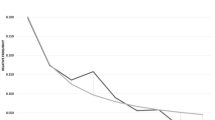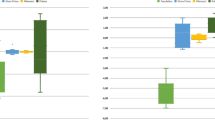Abstract
Digit distributions are a popular tool for the detection of tax payers’ noncompliance and other fraud. In the early stage of digital analysis, Nigrini and Mittermaier (A J Pract Theory 16(2):52–67, 1997) made use of Benford’s Law (Benford in Am Philos Soc 78:551–572, 1938) as a natural reference distribution. A justification of that hypothesis is only known for multiplicative sequences (Schatte in J Inf Process Cyber EIK 24:443–455, 1988). In applications, most of the number generating processes are of an additive nature and no single choice of ‘an universal first-digit law’ seems to be plausible (Scott and Fasli in Benford’s law: an empirical investigation and a novel explanation. CSM Technical Report 349, Department of Computer Science, University of Essex, http://cswww.essex.ac.uk/technical-reports/2001/CSM-349.pdf, 2001). In that situation, some practioneers (e.g. financial authorities) take recourse to a last digit analysis based on the hypothesis of a Laplace distribution. We prove that last digits are approximately uniform for distributions with an absolutely continuous distribution function. From a practical perspective, that result, of course, is only moderately interesting. For that reason, we derive a result for ‘certain’ sums of lattice-variables as well. That justification is provided in terms of stationary distributions.
Similar content being viewed by others
References
Benford F (1938) The law of anomalous numbers. Proc Am Philos Soc 78: 551–572
Bolton RJ, Hand DJ (2002) Statistical fraud detection: a review (with discussion). Stat Sci 17(3): 235–255
Gray RM (2006) Toeplitz and circulant matrices: a review. Found Trends Commun Inf Theory 2(3): 155–239
Kemeny JG, Snell JL (1976) Finite Markov Chains. Springer, NewYork
Nigrini MJ, Mittermaier LJ (1997) The use of Benford’s law as an aid in analytical procedures: audit. A J Pract Theory 16(2): 52–67
Rosenthal JS (1995) Convergence rates for Markov chains. SIAM Rev 37(3): 387–405
Schatte P (1988) On mantisse distributions in computing and Benford’s law. J Inf Process Cyber EIK 24: 443–455
Scott PD, Fasli M (2001) Benford’s law: an empirical investigation and a novel explanation. Technical report. CSM Technical Report 349, Department of Computer Science, University of Essex, http://cswww.essex.ac.uk/technical-reports/2001/CSM-349.pdf
Author information
Authors and Affiliations
Corresponding author
Rights and permissions
About this article
Cite this article
Dlugosz, S., Müller-Funk, U. The value of the last digit: statistical fraud detection with digit analysis. Adv Data Anal Classif 3, 281–290 (2009). https://doi.org/10.1007/s11634-009-0048-5
Received:
Revised:
Accepted:
Published:
Issue Date:
DOI: https://doi.org/10.1007/s11634-009-0048-5




